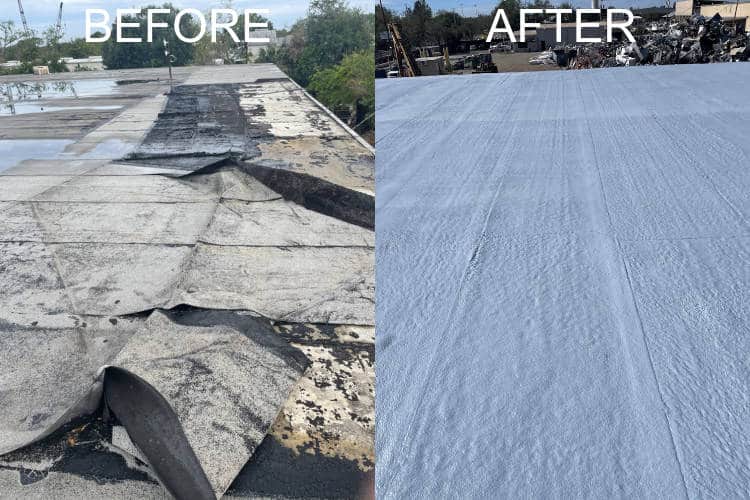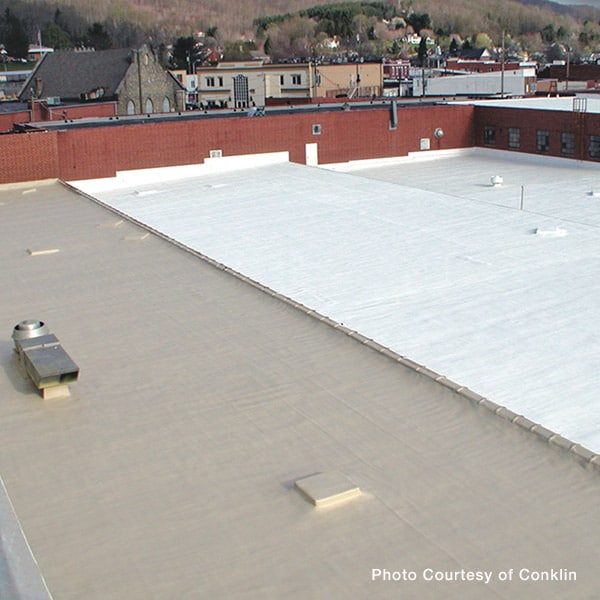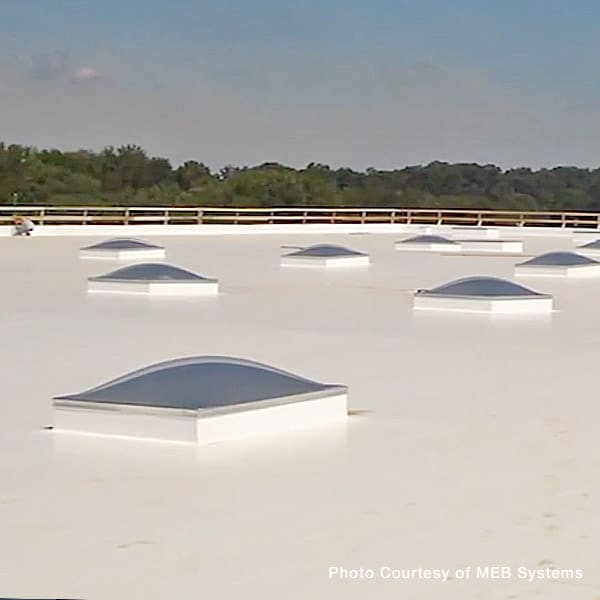Single Ply Roofing
Single-ply roofing is often constructed with a flexible thermoplastic membrane rolled out and secured to the roof deck. Many commercial building owners and developers often prefer them. They provide a cost-effective, durable, and watertight low slope roofing system that will protect the structure and its contents from the elements. In addition, the wider width of the material reduces the seams, which are often where roof leaks occur. This gives it a distinct advantage over other rolled roofing materials like asphalt.
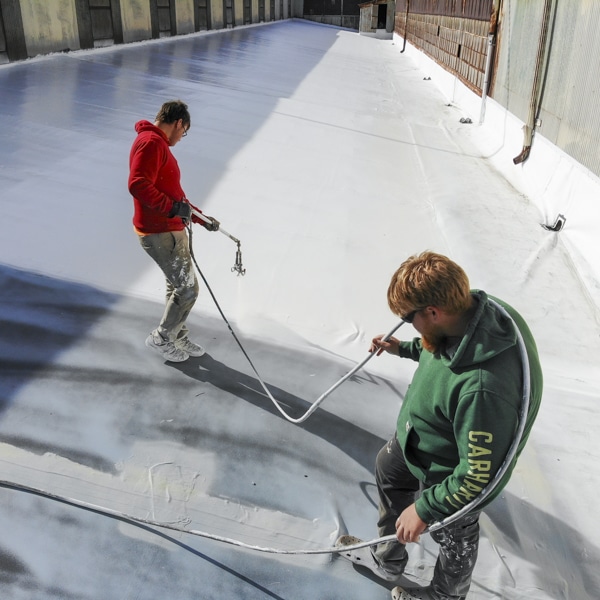
Eliminate Costly Tear-Offs on Single-Ply Roofing
Although single-ply roofing is highly durable, wear and tear, humidity and extreme weather conditions can weaken the surface. Thus, exposing it to moisture, dirt, and debris that can cause roof leaks and water-related damage to the roofing system. This can result in damage to the roof structure and therefore the interior contents. When this occurs, roofers typically tear off the old roofing materials to install a new membrane. Our Single-Ply Membrane and coating system can be installed on top of an existing roof deck. It can also be applied as a long-lasting, durable membrane for a new roof installation. Periodically recoating our seamless, single-ply coating system repairs, protects, and preserves your Flexion® and other approved membranes. This process virtually eliminates the need for costly tear-offs and roof replacements in the future, for as long as you own the building.
Enhanced Protection Against Water, Hail, Wind & Fire
The Conklin Single Ply Roofing System has a high-performing solar reflective elastomeric waterproof membrane coating for rugged leak-free protection against a wide range of seasonal weather and environmental conditions, including rain, hail, wind, and fire. It also resists dirt and discoloration for years of long-lasting, low-maintenance performance.
Lower Utility Costs with “Cool Roof” Energy Efficiency
Conklin’s white reflective singly ply membrane and coating system’s “cool roof” technology reflects 84 percent of the sun’s UV radiation, significantly outperforming other reflective surfaces. Its high energy efficiency keeps indoor spaces significantly cooler. In addition to improved HVAC performance, business owners can save up to 30% in cooling costs alone during those hot and humid summers in the Sarasota-Bradenton area and throughout Florida. In addition, your business may qualify for tax credits, utility rebates, and other incentives that can offset your roofing system investment. Many satisfied customers noticed that our single-ply coating system paid for itself within the warranty period. Conklin’s single-ply membrane and coatings are part of the EPA’s EnergyStar program and rated by the Cool Roof Rating Council (CRRC).
Single-Ply Coating System Advantages
Simply put, Conklin’s single ply coating system installed by Troyer Commercial Roofing gives Sarasota FL commercial buildings with low slope roofs a weather-resistant roofing system with long-lasting performance and lower total lifecycle cost that is unsurpassed by many other commercial roofs. With these outstanding benefits, business owners, property, and facility managers can avoid future tear-offs and replacements:
- Superior waterproofing protection stops and eliminates leaks on single-ply roofing.
- Exceptional weather resistance to wind and hail.
- High solar reflectivity protects the roof from UV radiation and discoloration.
- High energy efficiency reduces utility costs all year long.
- Renewable coating virtually eliminates costly tear-offs and roof replacements.
- EnergyStar, Cool Roof Rating Council (CRRC) rated, and FM Approved.
- We offer guarantees of up to 20 years on workmanship and coatings (depending on the coating chosen) with a non-prorated and extendable warranty.
 Free Roof Inspection Single-Ply Roofing in Southwest Florida
Free Roof Inspection Single-Ply Roofing in Southwest Florida
Troyer Commercial Roofing’s single-ply coating system can restore and protect your existing concrete, steel, or wood roof deck and approved membranes, virtually eliminating the need for future roof replacements. For a limited time, Troyer Commercial Roofing is offering free roof inspections for agricultural, commercial, and industrial facilities in Bradenton, Ellenton, North Sarasota, Palmetto, Venice, and surrounding Florida communities. Call to schedule an appointment for a free estimate today!
5 Top Benefits of Choosing Single-Ply Roofing
1. Durability and Flexibility
Single-ply roofing offers impressive durability while remaining flexible enough to withstand a range of environmental conditions. These systems are resistant to UV radiation, chemicals, and extreme temperatures, making them ideal for commercial buildings. Additionally, single-ply membranes like TPO and EPDM are designed to handle structural movement, reducing the risk of cracks or punctures. This durability ensures that businesses enjoy long-lasting protection without frequent repairs. With regular maintenance, a properly installed single-ply roof can last 20 years or more, providing excellent long-term value for building owners.
2. Cost-Effective Solution
One of the most appealing aspects of single-ply roofing is its cost-effectiveness. The material itself is relatively affordable, and its lightweight nature means that installation costs are often lower than other commercial roofing systems. Single-ply roofing can also be installed over existing roofs, reducing the need for costly tear-offs. This, combined with its durability and low maintenance requirements, makes it a highly economical option for businesses. Over time, the reduced need for repairs and the energy efficiency of single-ply roofing can lead to significant cost savings.
3. Energy Efficiency
Single-ply roofing systems, particularly those with white, reflective surfaces like TPO membranes, contribute significantly to energy efficiency. These roofs reflect a large percentage of the sun’s rays, helping to keep the building cooler during hot weather. As a result, businesses can experience reduced cooling costs, especially in warmer climates like Florida. The energy-saving benefits also help reduce a building’s overall carbon footprint, making single-ply roofing an environmentally friendly choice. Conklin’s single-ply systems, in particular, are known for their exceptional solar reflectivity, contributing to lower utility bills and enhanced HVAC performance.
4. Versatility
Single-ply roofing is a versatile solution that can be applied to a variety of building types and roof structures. It’s compatible with low-slope roofs and can be installed over different substrates, including concrete, steel, and wood. This versatility makes it a great option for commercial properties with varying needs. Whether it’s for new construction or roof replacement, single-ply membranes offer a flexible and reliable roofing solution. They also come in different thicknesses and colors, allowing building owners to select the material that best suits their specific requirements.
5. Ease of Installation
Single-ply roofing systems are known for their relatively easy and fast installation process. Due to their lightweight nature, single-ply membranes can often be installed without the need for reinforcing the existing structure. They can also be installed in large sheets, which reduces the number of seams—often the areas most vulnerable to leaks. This ease of installation reduces labor costs and minimizes disruption to business operations. With professional installation from a qualified contractor like Troyer Commercial Roofing, building owners can enjoy a seamless roofing system that offers long-term protection.
Already Have a Single-Ply Roof?
Here are 7 Signs Your Commercial Roof Needs Restoration or Repair
1. Visible Punctures or Tears
One of the clearest signs your single-ply roof needs repair is the presence of visible punctures, tears, or holes in the membrane. Single-ply roofing systems are designed to be durable, but sharp debris, heavy foot traffic, or extreme weather can create damage over time. Punctures compromise the waterproofing ability of the roof, leading to leaks and water damage. If you notice any physical damage to the surface, it’s important to contact a professional roofer immediately to prevent further deterioration.
2. Pooling Water
Single-ply roofing systems are meant to provide excellent water drainage. If you notice pools of water forming on your roof after a rainstorm, this could indicate that your drainage system is not working properly, or that the roof membrane has lost its slope. Prolonged standing water can weaken the membrane and increase the risk of leaks. Pooling water on a single-ply roof should be addressed quickly, as it can significantly reduce the lifespan of your roof if not corrected.
3. Loose Seams
Since single-ply roofing membranes are installed in large sheets, seams are one of the most vulnerable parts of the system. Over time, these seams may loosen or lift due to age, improper installation, or extreme weather conditions. Loose seams allow water to seep under the membrane, leading to leaks and moisture buildup. Inspect your roof regularly to ensure that the seams are still securely fastened. If you notice any separation, professional repair is necessary to prevent water infiltration.
4. Blistering or Bubbling
Blisters or bubbles under the single-ply membrane indicate that air or moisture has become trapped beneath the surface. This problem often results from poor installation or aging materials. Blistering weakens the membrane, making it more susceptible to tearing and leaks. Left untreated, these blisters can expand and create further damage to your roof. Addressing this issue early with repairs can prevent larger, more expensive problems from developing.
5. Roof Leaks or Water Stains
If you notice water stains on the ceiling or walls of your building, it’s a clear indication that your single-ply roof has a leak. Water intrusion can cause structural damage and mold growth if you do not address it quickly. Leaks often occur due to punctures, worn-out seams, or aging roofing materials. Inspect your roof for any visible damage, and if leaks are detected, contact a professional roofer to perform the necessary repairs before the damage worsens.
6. Membrane Shrinkage
Over time, single-ply roofing membranes can shrink due to age, temperature fluctuations, or exposure to UV radiation. When the membrane shrinks, it pulls away from the roof edges, flashing, or seams, leaving these areas vulnerable to water infiltration. Shrinkage can also lead to cracking or tearing of the membrane itself. If you notice that your single-ply roofing is pulling away from the roof’s edges or other critical points, it’s time to schedule repairs before it leads to more extensive damage.
7. Cracking or Drying Out
Prolonged exposure to harsh sunlight and high temperatures can cause single-ply roofing membranes to dry out and become brittle. Over time, this can result in cracks or splits in the surface, which compromises the roof’s ability to keep water out. If your roof appears dried out or has visible cracks, these are warning signs that repairs are needed. Addressing these issues early can help prevent more costly repairs down the line and extend the life of your roof.
Top FAQs About Single-Ply Roofing
What is single-ply roofing?
Single-ply roofing is a flat or low-slope roofing system made from flexible membranes. These membranes are typically composed of thermoplastics like TPO, PVC, or synthetic rubber such as EPDM. Single-ply roofing is applied in large sheets, making installation fast and reducing the number of seams where leaks could occur. This roofing option is popular for commercial buildings due to its durability, weather resistance, and cost-effectiveness, providing excellent protection against water infiltration and UV damage.
What types of single-ply roofing are available?
The most common types of single-ply roofing are TPO (Thermoplastic Olefin), PVC (Polyvinyl Chloride), and EPDM (Ethylene Propylene Diene Monomer). TPO is known for its energy efficiency and cost-effectiveness, while PVC offers strong chemical resistance and durability. EPDM is a synthetic rubber roofing membrane that provides excellent weather resistance and flexibility. Each option has unique advantages, so the right choice depends on your building’s needs, climate, and budget.
How long does a single-ply roof last?
The lifespan of single-ply roofing varies based on the material and quality of installation, but most systems can last between 20 to 30 years. Regular maintenance and inspections are essential for ensuring maximum lifespan. The durability of single-ply roofing, particularly with quality membranes like EPDM or PVC, makes it a cost-effective long-term solution for commercial buildings. Recoating options and repairs can extend its life even further, reducing the need for full roof replacements.
Can single-ply roofing be installed over an existing roof?
Yes, in many cases, single-ply roofing can be installed over an existing roof, eliminating the need for a costly tear-off. This can be done with proper preparation, including ensuring that the existing roof is clean and structurally sound. Overlaying a single-ply membrane on top of your current roof system offers a faster and more affordable way to restore your roof’s performance. However, a professional roofing contractor should assess the roof first to determine if this option is suitable for your building.
What maintenance does single-ply roofing require?
Single-ply roofing systems require regular maintenance to prevent issues like punctures, membrane shrinkage, or pooling water. It’s recommended to schedule inspections at least twice a year, as well as after any severe weather events, to check for damage, clear debris, and ensure the drainage system is functioning properly. Prompt repairs, such as fixing small punctures or resealing seams, help extend the roof’s life. Maintaining your single-ply roof keeps it durable and energy-efficient for years to come.

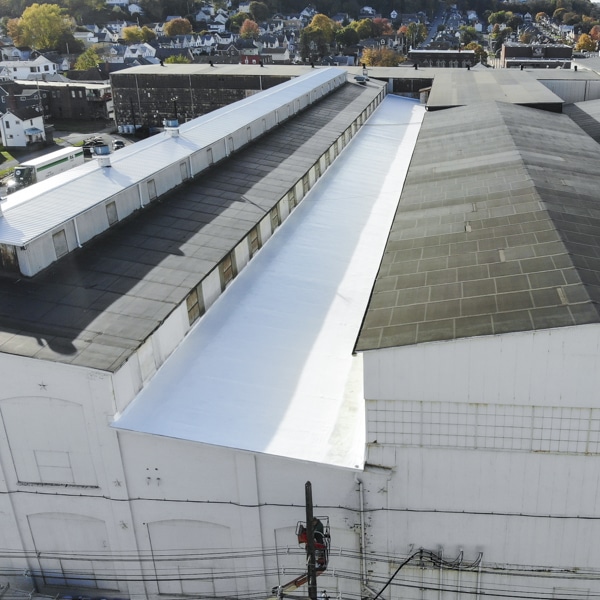 Free Roof Inspection Single-Ply Roofing in Southwest Florida
Free Roof Inspection Single-Ply Roofing in Southwest Florida